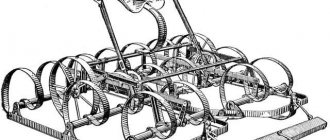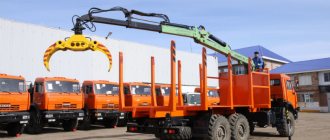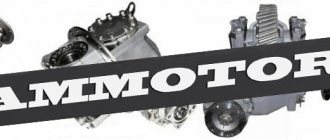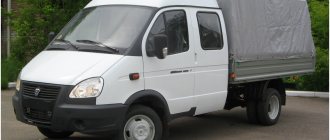Hello! Today we’ll talk about what transport logistics is and share tips on how to choose a transport logistics company. It is difficult to imagine a business that can exist, much less develop, without transporting various goods. Raw materials need to be delivered to production, finished goods to an intermediary, and from the intermediary to the consumer. Organize all movements while minimizing costs - this is the main task of transport logistics.
Concept
This is the area that is responsible for organizing the transportation of ordered goods to a specific location within a time agreed with the customer and along the most optimal route, designed to reduce financial costs. This includes three main points:
- delivery at low cost;
- the use of modern communication devices and equipment to control the process at all its stages;
- transfer of information about the cargo to its customer.
The key element of transportation is the vehicle. Approximately half of the total process costs are allocated to application and maintenance.
The main tasks of the direction: finding the most suitable type of transport, following work patterns and laying out profitable routes. This is part of the transport and logistics activities organized by transport companies.
Organization of the transportation system
The accumulated experience shows that intermodal transportation is the best solution to the problem. The work of a logistics company is to form an integrated system of cargo transportation, in which more than one mode of transport is simultaneously involved.
The logistics system is built on the well-coordinated cooperation of related industries - trade, industry, transport, forwarding services.
An organized system assumes the following:
- coordinated action of all participants in multimodal transportation to achieve a common goal;
- unification and consolidation of cargo items in order to optimize the planned process;
- ensuring control of all parts of the established process of the transport system;
- assistance in the development of the material and technical base of related companies - transport, loading mechanisms, container fleet;
- coordination of unified cargo parameters for possible transportation of cargo in a universal container container along the entire route;
- coordinated supply of transport to transshipment points;
- tracking the movement of containers with cargo;
- unification of transportation rules, registration of travel documentation according to uniform standards, facilitation of customs inspections;
- creation of uniform tariffs and rules for container transportation of goods.
Intermodal and multimodal transportation reduces costs, increases delivery speed, and contributes to the safety of cargo. First of all, this is due to the enlargement of the cargo unit. During container transportation, specific energy consumption per unit of cargo is reduced by 2-3 times.
A professional logistics company will build a transportation algorithm in the best way.
Using time-tested transport companies and logisticians:
- analyze possible delivery options from the perspective of road conditions, route length, and possible risks;
- calculate the average cost of transportation;
- will carry out cargo consolidation to reduce the cost of the process;
- monitor the work of suppliers;
- will select the best carriers;
- conclude the necessary contracts with new partners;
- monitor compliance with safety regulations and cargo storage conditions at all stages;
- will ensure the working condition of technical equipment.
History of the sphere
The first official “publication” of this phrase occurred at the European Congress held in Germany in 1974. The main goals were also outlined there for the first time: delivery of goods to an agreed point within a specified period and at minimal cost.
In the West, services began to be provided back in the 90s. According to expert analysis, market turnover grows by approximately 20% annually. But in Russia they took care of this only during the country’s transition to a market economy, so the development of transport and logistics services is not the fastest growing area. This is mainly due to the fact that there are no business plans, and one company employee has diverse functions.
Where to begin
If you want to create your own business in transport transportation, then the question arises - where to start?
First of all, you need to study the service market and select the appropriate segment. What will it be - passenger transportation or cargo delivery? The cargo transportation market is promising.
The trucking industry is filled with competing companies. However, small carriers account for 60% of the freight market.
Having sufficient start-up capital and healthy ambitions, you can organize your business from scratch.
A well-written business plan will help you organize your business correctly. It will help assess the potential of the planned business.
The next step will be to obtain permission for official activities from the Tax Inspectorate. To register as an individual entrepreneur you must:
- submit an application using the form;
- provide originals and copies of your passport and TIN;
- pay the duty.
After 5 working days, a OGRN certificate will be issued and you can begin your activities. You can start a business with one or two cars, a telephone operator to process incoming applications, and a driver. Another option is to hire drivers with personal cars. But in this case, you will have to give away the majority of the proceeds.
To develop a larger enterprise, you will need to purchase cars, select premises, hire experienced drivers and professional logistics forwarders. To promote your business, you will need advertising on all available resources.
By performing high-quality work on cargo delivery, you can quickly establish yourself on the positive side, have regular customers and quickly recoup the initial costs.
Views: 26,278
Ready-made solutions for all areas
Stores
Mobility, accuracy and speed of counting goods on the sales floor and in the warehouse will allow you not to lose days of sales during inventory and when receiving goods.
To learn more
Warehouses
Speed up your warehouse employees' work with mobile automation. Eliminate errors in receiving, shipping, inventory and movement of goods forever.
To learn more
Marking
Mandatory labeling of goods is an opportunity for each organization to 100% exclude the acceptance of counterfeit goods into its warehouse and track the supply chain from the manufacturer.
To learn more
E-commerce
Speed, accuracy of acceptance and shipment of goods in the warehouse is the cornerstone in the E-commerce business. Start using modern, more efficient mobile tools.
To learn more
Institutions
Increase the accuracy of accounting for the organization’s property, the level of control over the safety and movement of each item. Mobile accounting will reduce the likelihood of theft and natural losses.
To learn more
Production
Increase the efficiency of your manufacturing enterprise by introducing mobile automation for inventory accounting.
To learn more
RFID
The first ready-made solution in Russia for tracking goods using RFID tags at each stage of the supply chain.
To learn more
EGAIS
Eliminate errors in comparing and reading excise duty stamps for alcoholic beverages using mobile accounting tools.
To learn more
Certification for partners
Obtaining certified Cleverence partner status will allow your company to reach a new level of problem solving at your clients’ enterprises.
To learn more
Inventory
Use modern mobile tools to carry out product inventory. Increase the speed and accuracy of your business process.
To learn more
Mobile automation
Use modern mobile tools to account for goods and fixed assets in your enterprise. Completely abandon accounting “on paper”.
Learn more Show all automation solutions
Structure of cargo transportation by road by industry
Industry categories include road transportation associated with a specific type of activity:
- Agricultural - transport agricultural machinery, equipment, raw materials, products, animals;
- Industrial - raw materials, equipment, machines, finished products;
- Construction - construction equipment, machinery, repair kits, raw materials;
- Utilities - materials, equipment, utilities equipment;
- Trade - goods and equipment for trade;
- Postal - postal correspondence, parcels, parcels;
- Household - property of the population;
- Military - objects and special equipment for military purposes.
Basic functions and principles of transportation
This area was created in order to successfully store products and transport them from point A to B. This activity should be beneficial in all respects for the customer and the contractor: in terms of completion time and cost. Therefore, the list of key rules and characteristics of transport logistics organization includes:
- delivery forecasting and planning;
- legal support;
- calculation of payment for services provided;
- storage in a warehouse, as well as packaging of goods;
- improvement of transportation;
- preparation of necessary documents;
- information support;
- assistance with customs clearance and insurance.
Two approaches to organizing the transport process
The transport logistics process is organized according to one of two principles:
- Logistic;
- Traditional.
In the traditional approach, there is no multimodal transportation operator who manages the entire process of moving cargo. Participants interact sequentially. Information and financial flows in a traditional flow are transferred exclusively between adjacent links in the chain. It is not surprising that uniform tariffs are not established in such a chain.
In the logistics approach, everything is managed by a single transportation operator, due to which the communication scheme is transformed into a sequential-central one. In this case, general transportation tariffs appear.
Problems to be solved
The essence of the system is the function of timely delivery of products with minimal time and material costs. In practice, these goals are achieved by performing the following types of work:
- intermediate and final destination points are analyzed;
- an analysis of the cargo itself is carried out: its features, characteristics and properties;
- the question of which type of transport in logistics is the best option is resolved;
- it is determined which carrier is suitable, or specialized partners are hired;
- the most profitable route is being developed;
- the condition and safety of the goods during transportation are monitored;
- warehousing activities are carried out: packaging, packing of products;
- the main parameters of the process are optimized: increasing the rate of transportation, reducing fuel costs, as well as overall costs.
The choice of transport and route development depend on what kind of cargo needs to be transported. For example, the volume of the parcel affects the preparation of the car for the trip. And if dangerous or toxic substances are transported, a route will be established that bypasses settlements.
Rail freight transportation
Cargo transportation by rail is cheaper than by road. Their main disadvantage can be considered the speed of movement of the train to its destination. Freight cars can sit for a long time at intermediate stations, waiting for their trains.
When sending cargo by rail, you should take into account restrictions on the dimensions of the cargo, determined by the width and height of the cars.
In general, it is the cheapest and fastest mode of transport for transporting heavy loads over long distances.
Documents and their application
Everything about logistics in transport companies is enshrined in the Charter of Russian Railways and Automobiles. This is also the responsibility of the Merchant Shipping Code.
In addition, an agreement is concluded between the customer and the contractor, where the latter undertakes to transport the cargo to the agreed point B within a strictly specified period and according to a certain tariff plan. Transportation is accompanied by the following documentation:
- delivery note;
- power of attorney to transport the parcel;
- invoice from the contractor.
Other documents may also apply. All this depends on the chosen transport.
Delivery by rail
For Russia, the issue of delivering objects by train is especially relevant. The country's railway networks are considered the longest in the world. Railway transport is very reliable. Railroads are the second most popular and in demand delivery method. Unlike cars, the types of transportation and classification of trains allow you to be much more free with the dimensions of the delivered cargo. Using rolling stock, you can deliver quite heavy raw materials and objects. The number of cars attached to a train can be very large, which allows the maximum to be delivered in a short time in one trip and significantly reduces the cost of delivery. The disadvantages of railways include the need to draw up fairly detailed documentation, as well as the lack of strong mobility when drawing up a route - you need to take into account the loading schedule of the tracks and many other nuances.
Types of transport logistics
There are two directions in this area: internal, when goods are transported to the company and its subsidiaries, and external, when products are transported to consumers.
But there are a little more varieties of gears. These include:
- Multimodal. It is used in cases where a product needs to be delivered from another country, and for this purpose several types of means are used. For example, a train and a car or a plane and a ship.
- Unimodal. The route is designed so that one vehicle is enough.
- Intermodal. This method is similar to the first. The only difference is that the process is organized by one operator, but from two carriers.
- Mixed. Another type of transportation in logistics, where cargo transportation is carried out, for example, by car to the point where it is necessary to load the parcel onto the railway.
- Combined. Similar to the previous one, but more than two types are used.
Sea and river cargo transportation
One of the cheapest types of cargo transportation. This transport has virtually no size restrictions, but not every port can accept such cargo.
Not only goods are transported by water, but also bulk construction materials: sand, gravel, etc., as well as dry and liquid fuel.
90% of international cargo transportation is carried out by sea. The vast majority of maritime transport is carried out by containers using modern container ships.
Types of maritime transport
Sea freight can be divided into two broad categories.
Coastal shipping
Coastal shipping is an important means of transportation in all countries with long coastlines. It is a low-cost means of transport for transporting bulky goods such as coal, iron ore, etc. to the inland ports of the country.
international delivery
This means that goods must cross the ocean.
Advantages of transporting goods by water
It is considered the cheapest among other modes of transport.
The watercraft transport cargo smoothly due to the absence of shaking during transit. They are highly suitable for transporting fragile goods such as glassware, pottery, etc. without causing damage.
Most suitable for heavy loads.
There is less pollution in water transport.
Flaws
This is the slowest mode of transport. Compared to waterways, railways are a faster, safer and cheaper means of transportation.
Floods caused by the rainy season and lack of water inflow during the summer season affect the plying of watercraft.
Sometimes rivers also change their path. This leads to stoppages and uncertainty in the use of this mode of transport.
Endpoint Analysis
When starting to organize a process, the manager must lay out an approximate path. At the same time, he takes into account the properties of the product, as well as the geographical features of the area.
It may also happen that, while solving a problem, a specialist understands that he will have to involve several types of transport or will designate intermediate stops. It is important to do this at the first stage, because the information received will help you correctly determine delivery times, as well as correctly calculate the cost of the service.
Summing up
Modern logistics of road transport is a rapidly developing business area that is gaining momentum in all countries. This is quite reasonable, since the development of logistics in the global economy is an important condition for making a profit.
Transport logistics is a detailed analysis of a large number of factors, professional development of optimal routes and schemes for transporting goods of varying volumes and complexity. Professional transport companies provide high speed and reasonable cost for all operations performed. The implementation of competent logistics is currently mandatory for conducting and organizing the most efficient activities of companies operating in the field of international and intercity transportation.
Ready-made solutions for all areas
Stores
Mobility, accuracy and speed of counting goods on the sales floor and in the warehouse will allow you not to lose days of sales during inventory and when receiving goods.
To learn more
Warehouses
Speed up your warehouse employees' work with mobile automation. Eliminate errors in receiving, shipping, inventory and movement of goods forever.
To learn more
Marking
Mandatory labeling of goods is an opportunity for each organization to 100% exclude the acceptance of counterfeit goods into its warehouse and track the supply chain from the manufacturer.
To learn more
E-commerce
Speed, accuracy of acceptance and shipment of goods in the warehouse is the cornerstone in the E-commerce business. Start using modern, more efficient mobile tools.
To learn more
Institutions
Increase the accuracy of accounting for the organization’s property, the level of control over the safety and movement of each item. Mobile accounting will reduce the likelihood of theft and natural losses.
To learn more
Production
Increase the efficiency of your manufacturing enterprise by introducing mobile automation for inventory accounting.
To learn more
RFID
The first ready-made solution in Russia for tracking goods using RFID tags at each stage of the supply chain.
To learn more
EGAIS
Eliminate errors in comparing and reading excise duty stamps for alcoholic beverages using mobile accounting tools.
To learn more
Certification for partners
Obtaining certified Cleverence partner status will allow your company to reach a new level of problem solving at your clients’ enterprises.
To learn more
Inventory
Use modern mobile tools to carry out product inventory. Increase the speed and accuracy of your business process.
To learn more
Mobile automation
Use modern mobile tools to account for goods and fixed assets in your enterprise. Completely abandon accounting “on paper”.
Learn more Show all automation solutions
Briefly about tariffs
A tariff is a rate. In simple terms, it represents the price charged for transporting cargo. Freight acts as an alternative to tariff and is used in maritime transport. Rates vary based on several factors - consumers, types of cargo, classes of transport.
Each type of vehicle requires the use of special tariff systems. In road transport, the following calculations are used:
- piecework;
- contractual;
- tons and hours;
- by duration of transport operation;
- based on mileage;
- for leaving the place.
In railway transport, general, local and exclusive tariff options are used. At sea, it is customary to apply tariff and freight rates for scheduled and non-scheduled lines respectively.
Types of transport in transport logistics
Perhaps this is the most important stage in the entire process, because without it it is impossible to transport products. Most of the costs of achieving a goal depend on which type of movement is chosen.
The key criteria are speed, time period and price. But besides this, there are other components:
- features and value of the parcel;
- number and frequency of shipments - with a large volume of products;
- distance and geographical characteristics.
Also, all means of transportation are divided into several categories. By purpose:
- public;
- owned by a specific company;
- private.
Powered by:
- engine - thermal or hybrid, as well as electric vehicles;
- winds - ships with a sail;
- muscle - driven by people or animals.
But the main classification is based on the medium of travel: water, land or air. We will look at it in more detail.
Transport logistics: road transport
This includes vehicles powered by their own propulsion system. The list of their advantages includes:
- inexpensive tariffs;
- speed;
- a wide range of carriers;
- mobility;
- the most affordable option;
- possibility of transporting small quantities;
- regularity of flights;
- Parcels can be packed without relying on strict requirements.
But there are also disadvantages in this direction. Namely:
- maintenance is expensive;
- the degree of reliability is low (there is a risk of theft);
- the cost of transportation over long distances is too high;
- road and weather conditions directly affect delivery time;
- in road transport logistics, it is impossible to send goods many times due to low carrying capacity;
- The machine must be unloaded quickly.
Railway
This includes vehicles moving on rail tracks. Among their advantages:
- large quantities can be transported;
- weather and seasonality do not affect transportation;
- flights operate regularly;
- low cost;
- impressive routes are not a problem.
There are much fewer disadvantages here, but they still exist:
- trains are not as mobile as, for example, motor vehicles;
- carriers formed their own monopoly.
Pipeline
Pipes are used mainly for transporting liquids and gaseous cargo, less often for moving solid products, for example, capsules.
Advantages:
- a minimum of workers will be required for dispatch;
- this method is one of the most reliable: product safety is ensured by almost 100%;
- does not require high costs.
But there are also disadvantages to this type of transportation in logistics:
- the list of transported goods is too small;
- the direction is not intended for small parties.
Marine vessels
An excellent option for intercontinental transport. Advantages of this type:
- load capacity is very high;
- the cost is quite low;
- The cargo is definitely in good hands.
But there are more disadvantages here:
- due to the speed, you will have to wait a long time for the parcel;
- geography is limited;
- fastening and packaging of products is subject to stringent requirements;
- flights are rare.
River boats
This solution is a priority in areas where there are no railway lines or airports. Pros:
- large quantities can be sent;
- transportation capacity at a high level.
But it should be borne in mind that the logistics of these transport operations also have disadvantages:
- used for movement in a limited number of areas;
- weather conditions and season affect transportation;
- The cargo is delivered quite slowly.
Air
Mainly helicopters and airplanes are used here. Among the advantages:
- mobility at a high level;
- Huge shipments can be sent;
- the safety of the parcel is ensured;
- express;
- the timing is minimal, since the routes are short.
Flaws:
- high cost of tariffs;
- shipping locations are limited;
- strong weather impact on transportation.
In addition, for transportation in logistics there are other types of transport - spacecraft or submarines, as well as elevators.
Main types of freight transport
Cargo transportation can be:
- aquatic;
- railway;
- air transportation;
- automobile.
Water delivery is the transportation of goods by water vehicles, such as steamships, tankers and bulk carriers. Thanks to sea vessels, it is possible to transport objects to distant countries and to other continents. There are river and sea cargo transportation. River ones are divided according to criteria.
- By type of communication: internal - within one navigation (navigation), direct - within more than two river navigation, direct water - when using river and sea navigation, mixed - when working together with other types of transport.
- By batch size: ship cargo - the same type of cargo, with an identical name, going to the same place, guaranteeing the full load of the taken vessel. Prefabricated – consignments that weigh more than 20 tons, which do not guarantee the filling of the entire vessel, and have different final delivery points, which contributes to the disconnection of some objects from each other. Small cargo – cargo whose weight is less than 20 tons and is delivered under one consignment note.
Sea transportation is divided into dry cargo and liquid cargo. By type of navigation they are divided into small and large shipping companies, as well as deliveries abroad.
Water transportation is a convenient and inexpensive way to transport cargo to the other side of the planet. Tankers and bulk carriers are used to supply raw materials, but for small objects containers are used that are loaded directly onto the ship.
This type of transportation is one of the slowest, but also the cheapest among other types of transportation. Despite its minimal cost, it requires a lot of attention and strict compliance with the requirements of the customer and the company that provides such services.
Freight transport by rail is considered safe and economical. They provide the opportunity to transport large volumes of cargo and large objects. This type of transportation is carried out by the main types:
- transportation in containers (one of the most common types, intended for various consumer goods, industrial and technical goods, in large quantities, but the cargo must be packaged to avoid harm or damage);
- small transportation (cargo weighing up to 10 tons and a volume of slightly less than a third of the capacity of a covered wagon);
- light-tonnage (cargo weight 10-20 tons, volume no more than half of a 4-axle car);
- group (the cargo occupies more than one car and has the same arrival point);
- route (similar to group, but the goods can be divided into parts and have different destinations for unloading).
Air freight transports cargo using aircraft. This is the fastest method of transportation; delivery speed can take from an hour to several hours, and the distance during this time will be several thousand kilometers. Due to its speed, air transportation is considered the most expensive compared to others.
There are 3 main types of air travel: intracity, intercity and international.
Air transportation is also classified.
- General - simple transportation that transports piece cargo to a specific place and the customer is the owner of the transported goods.
- Passing - which use free transport going in the required direction.
- Prefabricated ones are very popular and low cost compared to others. A special feature is that the goods are stored in the warehouse until the required volume has been accumulated.
Road transportation is one of the most popular and in demand. This type of delivery is available to anyone, both an ordinary person and a large company. Delivery by car ensures fast delivery speed, reasonable price, minimal possibility of damage and no additional loading and unloading work.
Classification of cargo transportation by road is carried out according to the following territorial criteria:
- international - delivery to other countries is carried out;
- interregional - transportation of an object to different cities and regions, the distance is more than 50 km;
- suburban - transportation at a distance of no more than 50 km outside the city;
- urban - transportation of goods within one city;
- technological - movement of cargo throughout the territory of a factory, complex, etc.;
- inter-district - delivery within administrative or economic regions, in neighboring areas within the country.
There are main types of transportation by car depending on the size of the cargo.
- Oversized. An object whose dimensions exceed the permissible requirements for moving by one vehicle is oversized; permits from utility services and special documents are required to move it around the city;
- Prefabricated. Movements in which vehicles are filled with small-sized goods from different customers with the same destination. This type is the most economical;
- Massive. Transportation of homogeneous cargo in large volumes.
By industry characteristics there are:
- trading;
- industrial;
- transportation of construction materials;
- delivery of postal items;
- transportation of agricultural goods;
- transportation of property of the population.
In addition to the listed classifications, there are also signs: seasonal, permanent and temporary. Seasonal transportation is carried out in a specific season - the delivery of vegetables at the time of their ripening and harvesting. Permanent ones are carried out regularly, regardless of the season - loads for production. Temporary transportation is carried out as needed.
Having studied the concept and types of transportation, the question arises, what are the features.
Car cargo transportation can be large or oversized.
Pros and cons of vehicles
| Variety | + | — |
| Cars | Affordable price Fast delivery Ability to transport small shipments Mobility Diversity of carriers in vehicle logistics Product packaging with minimum requirements | Risk of theft Expensive maintenance Small load capacity Foreign routes are too expensive Transportation is highly dependent on weather and road conditions Requires fast loading and unloading operations |
| Trains and trains | Can carry a huge volume Frequency and stability of flights Weather does not affect delivery Low cost High speed | Minimal transportability |
| Water | Minimum expenses Maximum cargo conservation Almost unlimited load capacity | Departures occur rarely Transportation geography is very limited Strict rules for product packaging |
| Air | Mobility Large shipments can be transported | Strong dependence on weather conditions |
Delivery by water
When deadlines are not too pressing, but you want to save money, they use delivery by sea vessels. Sea transportation is most in demand in the raw materials sector, where very heavy and voluminous cargo is provided for delivery. This is one of the oldest and traditional delivery methods.
When choosing the best option for transporting something from one point to another, the main criteria will be delivery time and cost. Sometimes the client may be interested in a list of cargo requirements and documentation. Thanks to such a well-developed system, you can choose the most comfortable and profitable method for yourself, even without being a professional familiar with the specifics.
Tariffs in transport and logistics companies: what are they?
All costs depend on the cost of transportation, which, in turn, depends on the tariff plan or freight (by sea) - the price tag for transportation indicated by the carrier. All this reimburses the organization for expenses and also generates profit. The rate is divided into several categories:
- by type of delivery options;
- by type of product;
- by consumers.
Each product has its own prices. For example, for vehicles they are divided into:
- transaction;
- ton/hour;
- distance;
- agreement;
- time period.
For railway:
- are common;
- local;
- exceptional.
For marine:
- installed;
- freight
Transport Operations Groups
Types of transportation organization are correlated with groups of transport operations, namely:
- the first group includes steps to prepare an import-export transaction - analysis of the transport market, study of prices, as well as essential conditions, route planning and other transportation details;
- the second group of operations is associated with the direct implementation of the terms of the contract (preparing cargo for transportation, preparing the relevant documentation, as well as monitoring the movement of goods along the route);
- the third group is associated with the possible emergence of disagreements and controversial issues between the sender of the cargo and its recipient after delivery has been completed.
Control of parcels during transportation
In the block about what transport and logistics is, we talked about information support for products. Let's explore this topic in a little more detail.
Companies try to use all modern navigation tools so as not to encounter unforeseen circumstances and have time to make changes to the developed route in time.
In addition, it is important to keep the client informed about what stage the delivery process is at and where his order is. Therefore, the service is closely related to high-quality and fast mobile communications and the Internet.
Road freight transportation
This is the most accessible and widespread type of cargo transportation. Transportation of goods using vehicles is the only way to move goods within populated areas.
For longer distances, road transport can be the cheapest and fastest delivery method.
Road transport is one of the most promising means for delivering goods over short and medium distances. It provides a number of benefits such as flexibility, reliability, speed and door-to-door service, and complements and improves the efficiency of other modes of transport.
Choosing a reliable organization
This is an equally important stage for all consumers. This includes:
- Specialization. A newly opened company may not deal with transportation directly, but act as an intermediary between the customer and the carrier, adding its own markup to the price. But large companies forwarding groupage parcels inspire more trust.
- Experience. The longer an enterprise has been on the market, the higher the likelihood that it already has a well-functioning transport logistics system.
- Team. The qualifications of specialists should not leave you in doubt, because how the goods will be transported depends on the employees.
- Technologies. This applies to mechanisms of interaction with consumers; the better they are, the easier the cooperation is.
Logistics of international transport
International cargo transportation from a logistics point of view is a combination of standards and rules of different countries. In the absence of uniform rules for the transportation of goods, international agreements are drawn up. Restrictions on the use of certain modes of transport may create additional problems for the transport of goods between states. When sending cargo, they are guided by the rules of the sending country, when receiving cargo, by the rules of the recipient country.
Differences in the development of different countries create problems for the formation of international logistics systems.
The main problems are the monopolization of the transport market by large companies, financial barriers and the specifics of sales markets.
Management and optimization
So, the basics of transport logistics for beginners say that the sphere is aimed at delivering parcels from point A to point B within a strictly established time frame and with minimal costs. Time and finances play an important role here, so the service should be beneficial to both parties. And here's how it's achieved:
- Preventing damage and loss of products.
- Reducing inventory in warehouses and in transit.
- Increasing the distance and volume of cargo. After all, transporting one shipment 400 km will be much cheaper than transporting three shipments 200 km. A large volume not only reduces the cost of transporting 1 unit, but also requires the use of railway and water transport, the price tag for which is much lower.
Content
- Transport logistics as part of logistics science
- History of the industry
- Transport logistics in Russia
- Fundamentals of transport logistics, functions of transport logistics
- Types of transport logistics
- Two approaches to organizing the transport process
- Tasks of transport logistics
- End point analysis
- Analysis of cargo properties
- Choice of transport
- What are tariffs
- Building an optimal route
- Cargo control during transportation
- How to choose a transport company
- Unified transport and warehouse logistics
- Optimization and management of transport logistics
- Automation of transport logistics
- Documentation in transport logistics
- Conclusion
Development of the direction in Russia: problems and prospects
The difficulty lies in the fact that there are no strictly defined rules to regulate individual divisions of logistics companies. The same employee can perform several duties at once without having the necessary knowledge and experience.
But this does not mean that things are completely bad in this area. In the Russian Federation it is developing, but at the same time it lags behind its foreign colleagues. This is due to the fact that:
- The economic situation in the country and on the world market is unstable.
- The condition of the roads leaves much to be desired.
- A small number of companies are engaged in packaging production.
If all these factors are normalized, the growth rate can increase significantly.
How to choose the right transport company for cargo transportation - advice from an expert for beginners
Having understood what transport logistics is, you can move on to solving specific problems - choosing a company that can provide fast and high-quality transportation of goods.
It is very important to consider:
- Company experience. The age of a company involved in the transportation of goods is an indicator of its stability and indicates a well-functioning operating mechanism.
- Work technologies. Companies with extensive practical experience have already managed to establish certain technologies that allow them to achieve positive results. Close interaction with contractors at various stages of delivery allows us to resolve any issues that arise.
- Company personnel. All full-time employees must be one and have sufficient practical experience. This is the key to the professionalism of any company.
- Specialization of a logistics company. Small logistics companies in most cases turn out to be only intermediaries. Trusted companies that specialize in the delivery of groupage cargo cannot be small by definition. Such a service provider may be worth considering.
- Features of transportation of products produced by your company. When choosing, it is more advisable to give preference to the contractor who has been transporting similar products for a long time.
In our opinion, transport ]GLP[/anchor], which provides cargo transportation services in Moscow and the Moscow region, meets all of the above criteria. The company also has an Instagram account.
The team of the website HiterBober.ru is personally acquainted with the company’s management. So, friends, if you need to transfer cargo, feel free to contact the guys from GLP, our portal HeatherBober.ru vouches 100% for their quality of work.
The company's long-term representation in the service market is a guarantee that the company solves its problems efficiently and withstands competition with other companies.
It is most advisable to use the services of a carrier that has been operating for more than five years. The easiest way to find such information is on thematic forums.
All logistics company personnel must quickly respond to emerging difficulties and various conflict situations. The qualifications and practical experience of full-time employees should not raise any doubts.
For example
There was a slight delay in delivery of the cargo due to customs procedures. A reliable service provider will provide compensation to the customer in such a situation.
Features of route development
To increase the efficiency of transport logistics, different types of routing are used:
- circular – movement of vehicles along a closed path that connects several loading and unloading points;
- pendulum – transportation in forward and reverse directions between two points several times;
- assembly - sequential passage of a vehicle through several loading points for the purpose of loading (collecting) goods for delivery to the unloading point;
- distribution – delivery of goods by one transport from one loading point to different delivery points;
- distribution and collection – combined operations for the collection and distribution of goods.
A competent choice of route allows you to optimize the time and costs of delivering goods.











